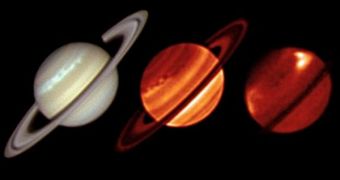Astronomers are now beginning to get more accurate insights into a massive storm that occurs on the surface of Saturn, causing the gas giant to change its overall appearance. Such impressive storms take place only once in a generation, investigators say.
The most common effects such events trigger are the development of cold vortexes and hot spots in the atmosphere. Scientists hope that the data extracted from studying this phenomenon could lead to a better understanding of the behavior of gas giants.
This knowledge could then be expanded to similar planets orbiting other stars in the Milky Way, or in other galaxies. On Saturn, massive storms occur once per year, or once per 30 Earth years.
Generally, the planet's surface looks calm, but that all changes when spring comes to its northern hemisphere. The current storm began around December 5, 2010, Space reports.
Normal temperature, wind patterns and atmospheric composition were changed drastically within a single month, especially in an area spanning between 20 and 50 degrees latitude north. The region is about 87,000 miles (140,000 kilometers) wide.
Since 1876, when more in-depth observations of Saturn began, astronomers noticed only six such tempests. But the latest is the best understood, thanks to radio and plasma wave science instruments aboard the NASA Cassini orbiter.
The spacecraft has been studying the gas giant, its moons and its ring system since July 1, 2004, when it achieved orbital insertion around Saturn. During the last few years, it managed to provide a wealth of data on phenomena that were only theorized to take place there.
“This disturbance in the northern hemisphere of Saturn has created a gigantic, violent and complex eruption of bright cloud material, which has spread to encircle the entire planet,” says Leigh Fletcher.
The researcher holds an appointment as a planetary scientist at the University of Oxford, in England.
“Previous studies of these storms have only been able to use reflected sunlight, but now, by observing thermal infrared light for the first time, we can reveal hidden regions of the atmosphere and measure the truly spectacular changes in temperatures and winds associated with this event,” he adds.
“We didn't see anything like that in previous storms, but then again, we didn't have the resolution or the infrared capabilities to do so,” Fletcher says. Details of the new study appear in the May 19 issue of the top journal Science.
“I don't think we expected something quite so complex or beautiful to emerge from this storm system, and given that it's embedded in this turbulent weather system, we can't say how long it might last,” he concludes.

 14 DAY TRIAL //
14 DAY TRIAL //